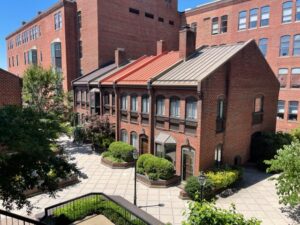Georgetown history is an integral part of this fascinating neighborhood located in Washington, D.C.. People love the historic townhomes, the cobblestoned streets and brick sidewalks, the waterfront properties along the Potomac River, and the luxury real estate that has been owned by senators and diplomats. Many parents buy homes here for the Georgetown University students while others choose to downsize and move here from around the DMV, drawn by the walkability and great restaurants.
Early Georgetown History – Which George?
Georgetown’s history began with a land grant issued in 1632 to Lord Baltimore, the proprietor of the Maryland Colony. The area that would later become Georgetown was originally part of Maryland. before becoming part of the District of Columbia.
GEORGE GORDON
While many people assume that Georgetown was named for King George of England, this is possibly a mistake. Georgetown history suggests that Georgetown was named for George Gordon, a Scottish immigrant and wealthy landowner, who very well known in the Maryland colony. He served as the Sheriff of Frederick County, as well as the judge of its first court. In the 1730s, he purchased the 300-acre Rock Creek Plantation, a tobacco farm on the banks of the Potomac River.

A few years later, hoping to establish successful trade in the area, he built a riverside inspection and trading house for his tobacco crop, located near the mouth of Rock Creek. The introduction of lucrative trading also benefitted Gordon’s neighbors—including George Beall, who owned the nearby plantation called “Rock of Dunbarton.”
This small tobacco industry became so prosperous that, in 1751, the Maryland Colonial Assembly appointed commissioners to lay out a new town around Gordon’s inspection house. After surveying the area, the commissioners decided that the land “most convenient” for building belonged to Gordon and Beall.
Though offered suitable compensation for the seizure of their land—fair prices per acre, plus the promise of well-placed town lots for their homes—Gordon and Beall clearly weren’t happy with the arrangement. When Beall finally gave in and accepted the commissioners’ terms, it was only because “if I must part with my property by force, I had better save a little than be totally demolished.” Construction went ahead, so that George Gordon’s and George Beall’s land became a new settlement known as George Town.
OR KING GEORGE?
But while it might seem fair to name a town after the two local landowners who gave their land for it, there still is some belief that Georgetown was named after King George II of England. The one thing that is clear is this part of Washington DC is named Georgetown.
During the American Revolution, Georgetown played a significant role. The town was home to many prominent figures, including George Washington, who selected the location for the capital city and signed the Act of Congress establishing Georgetown College (now Georgetown University) in 1789.
Georgetown History in its Buildings
Georgetown is not Disney World or Williamsburg. It is not a plastic collection of buildings designed to trick you into thinking you have gone back in time. Instead, it is a part of Washington that is home to people who love its tree-lined streets, the parks and gardens, brick walkways and charm a-plenty. Still, there are several historically significant homes in Georgetown that date back to the 18th and early 19th centuries.
Old Stone House:
The Old Stone House is the oldest unchanged building structure in Washington, DC. The house is also Washington’s last pre-revolutionary colonial building on its original foundation. Built in 1765, Old Stone House is located at 3051 M St NW. It was preserved from demolition, unlike many colonial homes in the area that were replaced by redevelopment, by local activists.
The Old Stone House was constructed in three phases during the 18th century and is an example of vernacular architecture. The house was built as a one-story structure. Additions were later made, and it was used both as a residence and for business. In the mid-20th century, at one time, it was the site of a used-car dealership. After acquisition and renovation by the National Park Service in the 1950s, the Old Stone House was adapted as a house museum. The Old Stone House stands proudly on M Street, surrounded by neighborhood stores and restaurants. The building was listed on the National Register of Historic Places in 1973. Today, the home is 85% original to its 18th-century construction.
Dumbarton House: Constructed in 1799, the Dumbarton House is a Federal-style mansion that served as the residence of prominent figures throughout its history. Today, it operates as a museum and offers a glimpse into the early days of the capital.
Tudor Place: Completed in 1816, Tudor Place is a neoclassical-style mansion and was the residence of Martha Washington’s granddaughter, Martha Custis Peter. The house is now a museum and showcases a vast collection of family artifacts and historical items.
Where to Live in Georgetown
There are lots of homes in Georgetown ranging from studio condos to historic residences claiming a connection with George Washington and General Lafayette. There are traditional colonial styled homes with narrow staircases and modern condos with walls of glass providing incredible views of the Potomac River. There is a perfect match for you in Georgetown, limited only by your tastes and your bank account! To find that perfect home, give the Lise Howe Group a call at 240-401-5577 or email us at lise@lisehowe.com. Click here to start your search!
and General Lafayette. There are traditional colonial styled homes with narrow staircases and modern condos with walls of glass providing incredible views of the Potomac River. There is a perfect match for you in Georgetown, limited only by your tastes and your bank account! To find that perfect home, give the Lise Howe Group a call at 240-401-5577 or email us at lise@lisehowe.com. Click here to start your search!
Georgetown Properties
